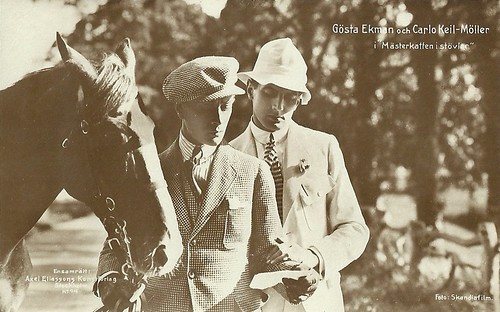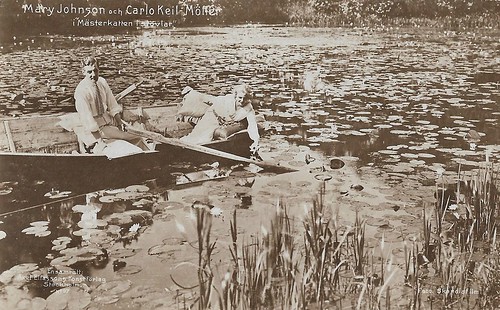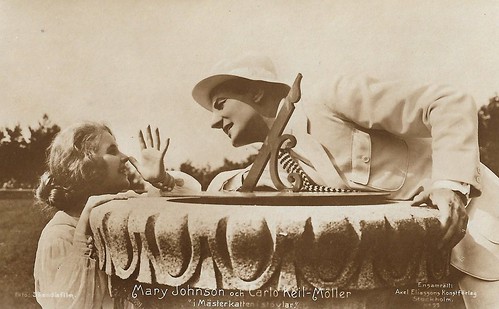
Swedish postcard by Förlag Nordisk Konst, Stockholm, no. 1225. Photo: Ferd. Flodin, Stockholm.

Swedish postcard by Förlag Nordisk Konst, Stockholm, no. 1226. Photo: Ferd. Flodin, Stockholm.
A rich estate owner, incapable of running his affairs
Carl Otto (Carlo) Keil-Möller was born in 1890 in Örgryte, Sweden. He was the son of Johan Mauritz Möller, a city broker, and Olga Antonia Keil. He grew up in Gothenburg and after graduating in 1910, he studied at Uppsala University, which resulted in a Bachelor of Arts degree in 1914.
After studying theatre with Louise Fahlman, Signe Hebbe and Gustaf Fredrikson, he made his professional theatre debut in 1915 at the Intima Theatre He there remained until 1921 and often acted under the direction of Einar Fröberg in plays by Strindberg, Molière, Hauptmann, Shakespeare, and others.
Between 1922 and 1927 Carlo Keil-Möller acted at the Helsingborg City Theatre, often under the direction of Torsten Hammarén and Gerda Lundequist-Dalström, later also Gösta Cederlund.
Carlo Keil-Möller debuted on screen opposite Gösta Ekman and Mary Johnson in the Skandia production Mästerkatten i stövlar/Puss in Boots (John W. Brunius, 1918). In this film he played a rich estate owner, incapable of running his affairs, so Ekman as the 'Puss in Boots' helps him out. Johnson played his love interest.
At Skandia, Keil-Möller and Johnson were reunited in Robinson i skärgården/A Modern Robinson (Rune Carlsten, 1920), while together with Ekman they were also reunited in En lyckoriddare/ A Fortune Hunter (John W. Brunius, 1921). In the latter Ekman is the dashing rogue who steals Johnson's heart.

Swedish postcard by Axel Eliassons Konstförlag, Stockholm, no. 94. Photo: Skandiafilm. Gösta Ekman and Carlo Keil-Möller in the Swedish silent romantic film Mästerkatten i stövlar/Puss in boots (John W. Brunius, 1918).

Swedish postcard by Axel Eliassons Konstförlag, Stockholm, no. 97. Photo: Skandia Film. Mary Johnson and Carl Keil-Möller in Mästerkatten i stövlar/Puss in boots (John W. Brunius, 1918).

Swedish postcard by Axel Eliassons Konstförlag, Stockholm, no. 99. Photo: Skandiafilm. Mary Johnson and Carl Keil-Möller in Mästerkatten i stövlar/Puss in boots (John W. Brunius, 1918).
Two aristocrats who love fast cars - and each other
In 1923 Carlo Keil-Möller shifted to screenwriting, starting with Brunius' film Johan Ulfstjerna (John Brunius, 1923) with Ivan Hedqvist and Einar Hanson. He also scripted the comedy En piga bland pigor/A Maid Among Maids (John Brunius, 1924). In this film, Keil-Möller played the last male lead of his film career, opposite Magda Holm, who plays a fun-loving girl who breaks off her engagement and becomes a maid on a farm.
Keil-Möller ended his career in silent film by co-writing the Gösta Ekman vehicle Unga greven tar flickan och priset/The Young Count Takes the Girl and the Prize (1924), directed by Rune Carlsten, about two aristocrats who love fast cars - and each other. From 1927 to 1934, Carlo Keil-Möller worked as a theatre director at the Lorensberg Theatre and from 1934 to 1935 at the Gothenburg City Theatre.
Between 1935 and 1939, he co-wrote two films at Svensk Filmindustri that were filmed, the drama Äventyret/Adventure (Per-Axel Branner, 1936) starring Karin Swanström and the crime drama Ett brott/A Crime (Anders Henrikson, 1940). Two other scripts were never filmed. He co-directed one film, the comedy En flicka kommer till sta'n/A Girl Comes to the City (Carlo Keil-Möller, Thor Brooks, 1939), starring Isa Quensel.
In 1939, he was hired as the first director at Dramaten, where he remained until 1946. He became a specialist in staging comedies and he also wrote a number himself. In addition, from 1929 to 1943 Keil-Möller was a film reviewer at Göteborgs Handels- och Sjöfartstidning and from 1943 to 1945 at Morgontidningen.
Carlo Keil-Möller married Thomasine Stjernswärd, née Piper in 1947. Keil-Möller died in Blentarps parish, Skåne, in 1958 at the age of 68 and was buried in Sövde cemetery.

Swedish postcard by Förlag Nordisk Konst, Stockholm, no. 1228. Photo: Ferd. Flodin, Stockholm.

Swedish postcard by Ljunggrens Konstförlag, Stockholm, no. 5 Photo: Wolfenstein.

Swedish postcard by Ljunggrens Konstförlag, Stockholm, no. 7. Photo: Wolfenstein.
Sources: Svenskfilmdatabas, Wikipedia (English and Swedish) and IMDb.
No comments:
Post a Comment